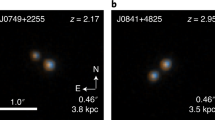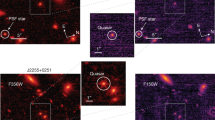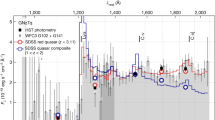Abstract
Galaxy mergers produce pairs of supermassive black holes (SMBHs), which may be witnessed as dual quasars if both SMBHs are rapidly accreting. The kiloparsec (kpc)-scale separation represents a physical regime sufficiently close for merger-induced effects to be important1 yet wide enough to be directly resolvable with the facilities currently available. Whereas many kpc-scale, dual active galactic nuclei—the low-luminosity counterparts of quasars—have been observed in low-redshift mergers2, no unambiguous dual quasar is known at cosmic noon (z ≈ 2), the peak of global star formation and quasar activity3,4. Here we report multiwavelength observations of Sloan Digital Sky Survey (SDSS) J0749 + 2255 as a kpc-scale, dual-quasar system hosted by a galaxy merger at cosmic noon (z = 2.17). We discover extended host galaxies associated with the much brighter compact quasar nuclei (separated by 0.46″ or 3.8 kpc) and low-surface-brightness tidal features as evidence for galactic interactions. Unlike its low-redshift and low-luminosity counterparts, SDSS J0749 + 2255 is hosted by massive compact disk-dominated galaxies. The apparent lack of stellar bulges and the fact that SDSS J0749 + 2255 already follows the local SMBH mass–host stellar mass relation, suggest that at least some SMBHs may have formed before their host stellar bulges. While still at kpc-scale separations where the host-galaxy gravitational potential dominates, the two SMBHs may evolve into a gravitationally bound binary system in around 0.22 Gyr.
This is a preview of subscription content, access via your institution
Access options
Access Nature and 54 other Nature Portfolio journals
Get Nature+, our best-value online-access subscription
$29.99 / 30 days
cancel any time
Subscribe to this journal
Receive 51 print issues and online access
$199.00 per year
only $3.90 per issue
Buy this article
- Purchase on Springer Link
- Instant access to full article PDF
Prices may be subject to local taxes which are calculated during checkout




Similar content being viewed by others
Data availability
The SDSS spectrum (Plate, 1,203; FibreID, 576; MJD, 52669) is publicly available at https://www.sdss.org/. The HST, Chandra, VLA, Gemini and Keck data are all available through their separate public data archives (HST programme nos. GO-16210 and GO-16892, Chandra GO-23700377, VLA 20B-242, Gemini 2020B-FT-113 and 2022A-Q-139). Source data are provided with this paper.
Code availability
The code used to model the HST and Keck data is publicly available at https://users.obs.carnegiescience.edu/peng/work/galfit/galfit.html. The code used for the lensing mass modelling test is publicly available at https://github.com/oguri/glafic2. The code used to perform the optical-NIR spectroscopic analysis is publicly available at https://github.com/legolason/PyQSOFit. The BAYMAX code used to model the Chandra data is available on reasonable request.
References
Hopkins, P. F., Hernquist, L., Cox, T. J. & Kereš, D. A cosmological framework for the co-evolution of quasars, supermassive black holes, and elliptical galaxies. I. Galaxy mergers and quasar activity. Astrophys. J. Suppl. Ser. 175, 356–389 (2008).
Bogdanović, T., Miller, M. C. & Blecha, L. Electromagnetic counterparts to massive black-hole mergers. Living Rev. Relativ. 25, 3 (2022).
Richards, G. T. et al. The Sloan Digital Sky Survey Quasar Survey: quasar luminosity function from data release 3. Astron. J. 131, 2766–2787 (2006).
Madau, P. & Dickinson, M. Cosmic star-formation history. Annu. Rev. Astro. Astrophys. 52, 415–486 (2014).
Schneider, D. P. et al. The Sloan Digital Sky Survey Quasar Catalog. V. Seventh data release. Astron. J. 139, 2360–2373 (2010).
Hwang, H.-C., Shen, Y., Zakamska, N. & Liu, X. Varstrometry for off-nucleus and dual subkiloparsec agn (VODKA): methodology and initial results with gaia dr2. Astrophys. J. 888, 73 (2020).
Shen, Y. et al. A hidden population of high-redshift double quasars unveiled by astrometry. Nat. Astron. 5, 569–574 (2021).
Barnacka, A., Geller, M. J., Dell’Antonio, I. P. & Benbow, W. Strong gravitational lensing as a tool to investigate the structure of jets at high energies. Astrophys. J. 788, 139 (2014).
Chang, K. & Refsdal, S. Flux variations of qso 0957 561 a, b and image splitting by stars near the light path. Nature 282, 561–564 (1979).
Wambsganss, J. & Paczynski, B. Expected color variations of the gravitationally microlensed qso 2237+0305. Astron. J. 102, 864–868 (1991).
Pooley, D., Blackburne, J. A., Rappaport, S., Schechter, P. L. & Fong, W.-f A strong X-ray flux ratio anomaly in the quadruply lensed quasar PG 1115+080. Astrophys. J. 648, 67–72 (2006).
Zezas, A., Alonso-Herrero, A. & Ward, M. J. Searching for X-ray luminous starburst galaxies. Astrophys. Space Sci. 276, 601–607 (2001).
Kellermann, K. I., Sramek, R., Schmidt, M., Shaffer, D. B. & Green, R. VLA observations of objects in the Palomar Bright Quasar Survey. Astron. J. 98, 1195–1207 (1989).
Sluse, D., Hutsemékers, D., Courbin, F., Meylan, G. & Wambsganss, J. Microlensing of the broad line region in 17 lensed quasars. Astron. Astrophys. 544, A62 (2012).
Contreras-Santos, A. et al. Galaxy pairs in The Three Hundred simulations: a study on the performance of observational pair-finding techniques. Mon. Not. R. Astron. Soc. 515, 5375–5388 (2022).
Shapley, A. E. Physical properties of galaxies from z = 2 to 4. Annu. Rev. Astron. Astrophys. 49, 525–580 (2011).
Ding, X., Silverman, J. D. & Onoue, M. Opening the era of quasar-host studies at high redshift with JWST. Astrophys. J. Lett. 939, L28 (2022).
Shangguan, J. et al. Chandra X-ray and Hubble Space Telescope imaging of optically selected kiloparsec-scale binary active galactic nuclei. II. Host galaxy morphology and AGN activity. Astrophys. J. 823, 50 (2016).
Shields, G. A. et al. LBQS 0103-2753: a binary quasar in a major merger. Astrophys. J. 744, 151 (2012).
Inada, N. et al. The sloan digital sky survey quasar lens search. ii. Statistical lens sample from the third data release. Astron. J. 135, 496–511 (2008).
Schechter, P. L. et al. First lensed quasar systems from the vst-atlas survey: one quad, two doubles, and two pairs of lensless twins. Astron. J. 153, 219 (2017).
Anguita, T. et al. The strong lensing insights into the dark energy survey (strides) 2016 follow-up campaign – ii. New quasar lenses from double component fitting. Mon. Not. R. Astron. Soc. 480, 5017–5028 (2018).
Lemon, C. A., Auger, M. W., McMahon, R. G. & Ostrovski, F. Gravitationally lensed quasars in Gaia – II. Discovery of 24 lensed quasars. Mon. Not. R. Astron. Soc. 479, 5060–5074 (2018).
Lemon, C. et al. The strong lensing insights into the dark energy survey (strides) 2017/2018 follow-up campaign: discovery of 10 lensed quasars and 10 quasar pairs. Mon. Not. R. Astron. Soc. 494, 3491–3511 (2020).
Tang, S. et al. Optical spectroscopy of dual quasar candidates from the Subaru HSC-SSP program. Astrophys. J. 922, 83 (2021).
Yue, M., Fan, X., Yang, J. & Wang, F. A candidate kiloparsec-scale quasar pair at z = 5.66. Astrophys. J. Lett. 921, L27 (2021).
Lemon, C. et al. J1721+8842: a gravitationally lensed binary quasar with a proximate damped lyman-α absorber. Astron. Astrophys. 657, A113 (2022).
Kochanek, C. S., Falco, E. E. & Muñoz, J. A. Why quasar pairs are binary quasars and not gravitational lenses. Astrophys. J. 510, 590–596 (1999).
Hennawi, J. F. et al. Binary quasars at high redshift. I. 24 New quasar pairs at z ∼ 3-4. Astrophys. J. 719, 1672–1692 (2010).
Hennawi, J. F., Prochaska, J. X., Cantalupo, S. & Arrigoni-Battaia, F. Quasar quartet embedded in giant nebula reveals rare massive structure in distant universe. Science 348, 779–783 (2015).
Peng, C. Y., Ho, L. C., Impey, C. D. & Rix, H.-W. Detailed decomposition of galaxy images. II. Beyond axisymmetric models. Astron. J. 139, 2097–2129 (2010).
Acknowledgements
We thank A. Kemball and A. Gross for helpful discussions on strong lensing. We thank M. Leveille, A. Vick, R. Campbell, R. McGurk, J. Cortes, T. R. Geballe, S. Leggett, A. Nitta, T. Seccull and H. Medlin for their help with our HST, Keck, Gemini and VLA observations. Y.-C.C. thanks J. Li and H. Guo for their help with the GALFIT and PyQSOFit codes. M.O. acknowledges support from JSPS KAKENHI grant nos. JP20H00181, JP20H05856 and JP22H01260. This work is supported by the Heising-Simons Foundation and Research Corporation for Science Advancement and National Science Foundation (NSF) grant nos. AST-2108162 and AST-2206499. This research was supported in part by the NSF under no. PHY-1748958. Support for programme no. 23700237 was provided by NASA through Chandra Award no. GO2-23099X issued by the Chandra X-ray Observatory Center, which is operated by the Smithsonian Astrophysical Observatory for and on behalf of NASA under contract no. NAS 8-03060. Support for programme nos. HST-GO-15900 (principal investigator (PI): H. Hwang), HST-GO-16210 and HST-GO-16892 was provided by NASA through grants from the Space Telescope Science Institute, which is operated by the Association of Universities for Research in Astronomy, Incorporated, under NASA contract no. NAS5-26555. The National Radio Astronomy Observatory is a facility of the NSF operated under cooperative agreement by Associated Universities, Inc. Based in part on data obtained at the W. M. Keck Observatory, which is operated as a scientific partnership among the California Institute of Technology, the University of California and the National Aeronautics and Space Administration. The Observatory was made possible by the generous financial support of the W. M. Keck Foundation. This research has made use of the Keck Observatory Archive, which is operated by the W. M. Keck Observatory and the NASA Exoplanet Science Institute, under contract with the National Aeronautics and Space Administration. We wish to recognize and acknowledge the very significant cultural role and reverence that the summit of Maunakea has always had within the indigenous Hawaiian community. We are most fortunate to have the opportunity to conduct observations from this mountain. Based in part on observations obtained at the international Gemini Observatory (programme nos. 2020B-FT-113 and GN-2022A-Q-139; PI: X. Liu), a programme of NSF’s NOIRLab, which is managed by the Association of Universities for Research in Astronomy under a cooperative agreement with the NSF on behalf of the Gemini Observatory partnership: the NSF (USA), National Research Council (Canada), Agencia Nacional de Investigación y Desarrollo (Chile), Ministerio de Ciencia, Tecnología e Innovación (Argentina), Ministério da Ciência, Tecnologia, Inovações e Comunicações (Brazil) and Korea Astronomy and Space Science Institute (Republic of Korea). This work was enabled by observations made from the Gemini North telescope, located within the Maunakea Science Reserve and adjacent to the summit of Maunakea. We are grateful for the privilege of observing the Universe from a place that is unique in both its astronomical quality and cultural significance. This work makes use of SDSS-I/II and SDSS-III/IV data (http://www.sdss.org/ and http://www.sdss3.org/, respectively).
Author information
Authors and Affiliations
Contributions
Y.-C.C. conducted the VLA and Keck observations, reduced and analysed the HST, Gemini and VLA data and performed GALFIT analysis and optical and NIR spectroscopic modelling. X.L. led the study, was PI of the Chandra, Gemini, HST and VLA observation programmes, conducted the Keck observations and reduced the Keck data. A.F. analysed Chandra data and performed BAYMAX analysis. Y.S. was PI of the Keck observation programme, conducted Keck observations and wrote the optical and NIR spectroscopic modelling pipeline. M.O. performed strong lensing mass model tests. N.C. performed cosmological simulations. X.L., Y.-C.C., A.F. and Y.S. co-wrote the manuscript with the help of N.C. and M.H. All authors contributed to the results and commented on the manuscript.
Corresponding author
Peer review
Peer review information
Nature thanks A. Barnacka and the other, anonymous, reviewer(s) for their contribution to the peer review of this work.
Additional information
Publisher’s note Springer Nature remains neutral with regard to jurisdictional claims in published maps and institutional affiliations.
Supplementary information
Supplementary Information
Supplementary Tables 1–8, Figures 1–14 and Methods.
Source data
Rights and permissions
Springer Nature or its licensor (e.g. a society or other partner) holds exclusive rights to this article under a publishing agreement with the author(s) or other rightsholder(s); author self-archiving of the accepted manuscript version of this article is solely governed by the terms of such publishing agreement and applicable law.
About this article
Cite this article
Chen, YC., Liu, X., Foord, A. et al. A close quasar pair in a disk–disk galaxy merger at z = 2.17. Nature 616, 45–49 (2023). https://doi.org/10.1038/s41586-023-05766-6
Received:
Accepted:
Published:
Issue Date:
DOI: https://doi.org/10.1038/s41586-023-05766-6
This article is cited by
Comments
By submitting a comment you agree to abide by our Terms and Community Guidelines. If you find something abusive or that does not comply with our terms or guidelines please flag it as inappropriate.



